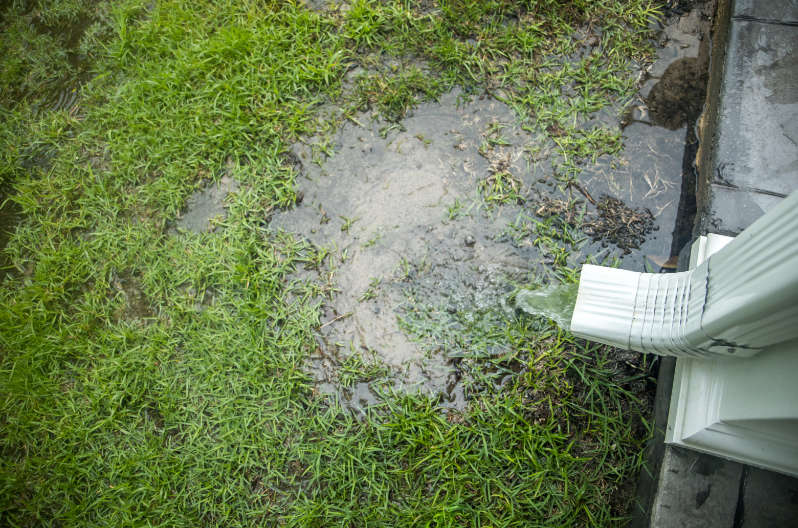Is your yard soggy every time it rains? Does your basement smell damp and musty? These could be signs you have a water drainage problem. A drainage problem around your home can lead to flooding, foundation damage, and even mold. Here are some of the common signs of a drainage problem. Plus, we look at the most effective ways of diverting water away from your home’s foundation.
What Are the Signs of a Drainage Problem?
Unless you have a lake in your yard or water in your basement, it’s easy to miss the signs of a water drainage problem. These are some of the signs you need to divert water away from your home:
- Soggy Yard
- Large Puddles
- Washed Away Mulch
- Overflowing Gutters
- Sparkly Basement Walls (Efflorescence)
- Damp and Musty Odors
- Mold
What Causes Water Drainage Problems?
The biggest cause of water drainage problems is the slope of your yard. Landscapers call this the grade of your yard. The land around your home should always slope away from your home. This slope will divert water away from your foundation. If your yard doesn’t slope, water can leak into your home and cause mold or a flood.
Your gutters can also lead to water drainage problems. Your gutters help water drain safely away from your home. If they get clogged, your gutters will overflow. This will wash away mulch and soil. Over time, this can ruin the slope of your yard and lead to drainage problems.
How to Divert Water Away From Your Foundation?
Here are the most effective ways to drain water away from your house:
Clean Your Gutters
Cleaning your gutter regularly is one of the best ways to prevent foundation drainage problems. As long as you don’t mind climbing up a ladder and getting a little dirty, it’s really cheap too.
Clean your gutters at least in the spring and fall. If you have a lot of trees near your home, you might want to clean them a little more often.
Another option is to install gutter protection instead. There are several options available that keep leaves and dirt out of your gutters so you don’t need to clean them.
Extend Your Downspouts
Most downspouts come down from your gutters and then end right at ground level. However, this can actually lead to foundation drainage problems, since all the water will pool right there.
If you don’t already have downspout extensions, you should add them to divert water away from your home. Pre-cut downspouts are inexpensive and available at most home improvement stores.
Your downspouts should end six feet away from your home. Directing them either towards a storm drain or out towards the street offers the best drainage protection.
Fix the Slope of Your Yard
If you’ve already dealt with your gutters and downspouts, the best way to divert water away from your foundation is by fixing the slope of your yard.
Dirt is inexpensive and you can do the work on a weekend with just a small shovel and a rake. Just spread the dirt out evenly around your home with the rake and then use the backside of the shovel to pack it down.
The soil at the base of your home should be about six inches higher than the rest of your yard and gently slope away for at least six feet.
Add a Rain Barrel
A rain barrel is another great way to reduce the amount of water in your yard. Plus, you can even use it to water your yard which will save you money on your water bill. Just place the barrel on a flat surface and connect it to one of your downspouts.
Make a Rain Garden
Another way to divert water from your foundation is with a rain garden. Rain gardens are made of plants that thrive in very wet conditions on top of layers of rocks, gravel, sand, and soil that help filter rainwater.
You should make your rain garden at least ten feet from your home. Then channel rainwater to your garden either with the slope of your yard or downspout extensions.
Seal Your Driveway
Most driveways run right along the side of the house. While you might not notice it, there is a small gap between them where water will pool.
You can prevent water drainage problems by sealing that gap with landscaping foam. Start by cleaning out any dirt or leaves, then apply the foam to create a waterproof seal.
Install a French Drain
If you consistently have water drainage problems, a French drain might be the best solution. A French drain is specially designed to collect rainwater and keep it out of your home.
These drains contain a pipe that collects rainwater and channels it away. They are usually covered with decorative gravel or stones to prevent clogs and keep the water flowing smoothly.
While you can install a French drain on your own, it is a lot of work. You should consider all of your drainage options before making this kind of investment.
If you have water damage or a flooded basement, Restoration Local is here to help. Call 1-888-443-3110 now for fast, reliable water damage restoration. We always offer a free in-home quote and can begin water removal immediately.





